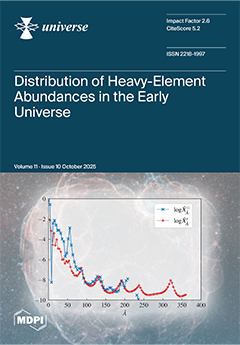Understanding the diversity of star formation histories (SFHs) of galaxies is key to reconstructing their evolutionary paths. Traditional models often assume parametric forms such as delayed-
or exponentially declining models, which may not reflect the actual variety of formation processes. We aim
[...] Read more.
Understanding the diversity of star formation histories (SFHs) of galaxies is key to reconstructing their evolutionary paths. Traditional models often assume parametric forms such as delayed-
or exponentially declining models, which may not reflect the actual variety of formation processes. We aim to assess what types of SFHs are consistent with the observed present-day star formation rates (
) and time-averaged star formation rates (
) of galaxies in the Local Volume, without assuming any fixed functional form. We construct a non-parametric framework by generating large ensembles of randomized SFHs for each galaxy in the sample. For each SFH, we compute its predicted stellar mass and present-day SFR and retain only those consistent with the observed values within a 20% tolerance. We then infer the statistical distribution of power-law slopes
(fitted as
) and 50% stellar mass formation times
. Across the full sample of 555 galaxies, we find that ≈70% have flat SFHs (
), ≈24% are mildly declining (
), and ≈6% are rising (
). In the low-mass bin (
), rising SFHs slightly increase (≈7%) but remain a minority as the majority have flat SFHs. Both
and
correlate strongly with the SFR ratio (Spearman
,
), indicating that the shape and timing of star formation are primarily governed by this ratio. The
distribution shows sharp spikes near 7.74 and 7.86 Gyr, which we attribute to grid discretization combined with filtering, rather than a physical bimodality. Our results confirm that strongly declining SFH templates are disfavored in the Local Volume: most systems are consistent with flat long-term SFHs, with only mild decline or occasional rising. Importantly, this is demonstrated through a fully model-independent, data-driven approach, with per-galaxy uncertainties quantified using the standard error of
and
from the ensemble of accepted SFHs.
Full article





